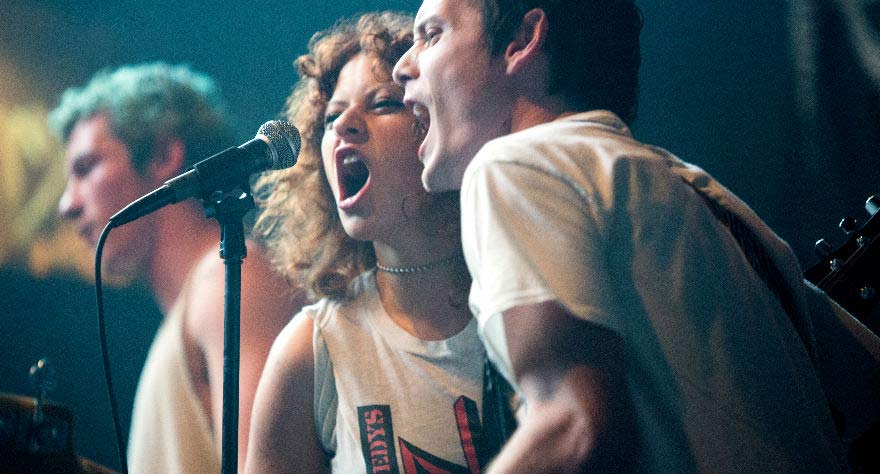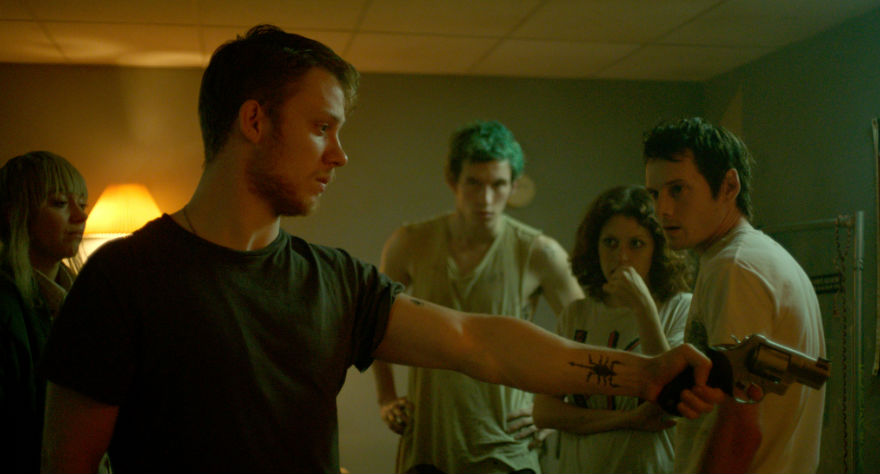Jeremy Saulnier and Anton Yelchin Talk ‘Green Room’

Green Room is sure to go down as the most overwhelmingly intense movie of 2016, and unless another filmmaker can match Jeremy Saulnier’s knack for suspense, violence, and pulling the rawest performances out of his actors possible, it’ll reign as genre-movie king for a good long while.
Starring Anton Yelchin, Imogen Poots, Alia Shawkat, Blue Ruin‘s Macon Blair, and Patrick Stewart, the film finds a hardcore band trapped in the green room of a secluded punk rock venue in the forested Northwest, surrounded and outnumbered by murderous neo-nazi thugs led by a cunning leader (Stewart). Over the course of one night, blood and limbs fly, bones break, flesh gets ripped to shreds, and egoes get smashed to pieces as we bear witness to the ensuing melee.
In a roundtable interview, we spoke to Saulnier and Yelchin in San Francisco about the movie, which is in theaters now.

Murder Party was also primarily shot in one location. That was shot about a decade ago. I’m curious how you’ve approached Green Room differently and how you’ve applied the things you’ve learned over the past ten years.
Jeremy: After Murder Party, which is an overnight, sort of contained scenario, I swore I’d never do it again. So…I’m an idiot. I learned a lot about what’s supposedly cheapest and most convenient, which is shooting a film in one location so that you have control over it. But, cinematically, I found it lacking. I was using a great steadycam operator and kind of set him loose, but I didn’t feel like it was fully realized, visually and cinematically.
For Blue Ruin, I did the opposite: tons of locations, open air, eight-page scenes. That was what I was attracted to. Green Room was just an idea I loved but was resisting because of the nature of what it contained. The siege scenario. But I felt like, because of the dynamics of it taking place in the green room of a concert venue during a live show, it was just something I couldn’t let go of.
Visually, I had an exterior element that was kind of swirling and always moving, very visually rich and kinetic. Inside, I had had to work on how to cover these scenes without exhausting the actors. I didn’t quite figure that out because you had to get these performances and you couldn’t be so kinetic. Green Room is much more visually precise and better realized. I wasn’t afraid. When we had to lock a camera and just shoot what the actor was saying, the impact of the performance is what’s really driving the story, not so much how I use the camera. We let the actors lead the way.
You’ve been DP on all of your films until now. What was it like passing on the torch and focusing on directing?
Jeremy: Based on the necessity of this production, it was easy and kind of inevitable. For Blue Ruin, it’s a kind of quiet film. There are about three major dialogue scenes, and the rest is primarily wordless. Every shot was the story. My intuitive approach to how I was moving the camera and how I was framing the camera is how I told the story. I couldn’t do it any other way.
Green Room, with the ensemble cast, the stunts, the bloodwork, the special effects…it was way more of a challenge than Blue Ruin. I wasn’t going to try to shoot this. Sean Porter was brought on because he has a diversity of styles. He isn’t trying to put his imprint on a director’s film. He tries to translate what they’re going for. I saw It Felt Like Love and Kumiko: The Treasure Hunter, which are very different films, and I would never peg them as being shot by the same person. For that reason, I knew that he could translate the visuals as I would have.
I love following your career, Anton. Your role choices are interesting to me. I don’t know you, but from everything I’ve heard, you’re an incredibly intelligent person.
Anton: That’s debatable…[laughs]
I think you exude a keen intellect when you’re onscreen. Do you choose roles that allow you to display that?
Anton: The thought just crossed my mind that I should find someone really stupid to play. [laughs] I think at this point I want to be doing different kinds of characters and changing physicality…It’s hard, because movies don’t really come out in order. Sometimes they never come out. So work that [I] do that in my mind I’m plotting my…not so much career trajectory, but my creative trajectory…a lot of times, people don’t get to see that. Something that I may have done three years ago may come out tomorrow, and three years ago I was on that creative page, but I’m not anymore! You get judged by that moment. For me, at this point, I’m trying to figure out what I can do creatively. It’s about trying to find new things and trying to figure out voices and borrowing from things and learning as much as possible so that I have an archive of things to borrow from.
Jeremy: I can attest to the fact that he is an overthinker. He gave me a huge phone book of notes about his character, not to change the script, but just his insights and how he would steer the character, emotionally. That I loved. Anton has a very good idea of what he wants to do, and he wants to talk about it a lot. Sometimes I want to, you know…
Anton: Not talk about it. [laughs]
Jeremy: This film is so physical. The dialogue, if you look at it line by line…it’s like, what are we saying here? It’s all kind of throwaway. But when you see the character, he’s not very proactive. He’s forced to live or die. He’s not trying to be a cinematic movie hero. He’s forced into that role and has to go kind of full-gonzo to get there. It’s really fun to see it come alive on camera.
Anton, are you the kind of actor who needs to be riled up before a tense scene? This film is obviously full of them.
Anton: It’s just focus. I know Jeremy’s really busy, but I send him all of that stuff. It’s a selfish thing. I need what I’m thinking to come out into the world, even if it’s a two-word approval, like, “Yeah, I agree,” I need that approval so that in the morning I can get up and use that when I go to work. It’s a weird version of focusing. That being said, it’s not just me focusing. I was thinking a lot about Callum and [Imogen] and Alia and Joe, watching those guys. Patrick Stewart on the other side of the door. When you’re part of a cast like this, you’re fortunate enough to have people who are constantly informing what you’re doing.
It’s very touching for me to see Callum’s face when I get hurt [in the movie]. The empathy and kindness he was exuding in that moment aided me so much. I love that guy, weirdly. We’ve never had an experience like that in real life, you know what I mean? He’s a great guy, and we’re friends. But there was something about that…you share really intimate things with people [on movies] that you just wouldn’t, even if you’ve been friends with them for years. You don’t share the things you’re forced to share [on a movie set].
The big thing I was scared of was that [the cast] would get together as a band and dislike each other.
Jeremy: That wouldn’t have happened. That’s how I cast movies.
Anton: Well, I was still scared, but those guys are good dudes. They’re good people.
Jeremy: The environment we create is, every actor on set wants to be there. They were invested. When you have that chemistry, that mutual support…it becomes real. Everyone feeds off of each other. When you’re in the room, you’re at the mercy of every single performance. You cannot have one that’s off. That real-life energy, that charge, was palpable in every take.
What’s the message of the picture?
Jeremy: There are lots of layers there. There’s subtle political commentary in there. There’s a thesis to the movie, and that’s more about stripping down ideology and affiliation and who we think we are in labels. It’s about a learned aggression and violence…all sorts of shit. But really, it’s entertainment. It’s about good, old-fashioned escapist filmmaking. Drawing from my favorite experiences with Blue Ruin, which were derived from watching audiences respond to intention…that was so fucking exhilarating for me.
With Green Room, what I wanted to do was infuse an archive, my experience in the punk rock and hardcore scene. I wanted to have something to show for it. I wanted to make a genre film but infuse it with the energy of the hardcore punk scene, which I really loved and also defined my youth.
What are some new things the movie brings to the table as far as genre filmmaking?
Jeremy: I really try to not let specific genres influence me. I’m certainly collectively influenced by all of the films I’ve ever seen. I did watch Straw Dogs for a reference. I knew this plot wasn’t going to be very thick. Straw Dogs was about the experience and tension and tone. A very thin plot. This is the point of Green Room. We’re not going for a convoluted plot. Contrived plot twists, injected character conflict or love stories that just don’t belong…it’s this insane, visceral experience. It’s an overnight clusterfuck, and it’s terrifying. It’s designed to be the most tense film I could ever imagine.
I approached it as a war film. That’s what it was. It’s a siege scenario. It has aesthetic elements that could be attributed to the horror genre. Certainly a lot of graphic violence. The way I approached it with the production design and the actors was that it was a very grounded war film, but on the other side of the door, there are amateurs.
We’ve been talking a lot about actors.
Anton: What’s wrong with that? [laughs]
[laughs] Jeremy, is there a technique you have when working with your actors?
Jeremy: [To Anton] What is my technique? No, seriously. Do I have a technique? I don’t perceive myself as having a technique.
Anton: I think, when you watch Jeremy’s movies, there’s a real sensitivity to performance. There are two parts of me. There’s the really critical, film-nerd part of me that loves that, and then there’s the part of me where I’m like, “I really didn’t like that movie, but I want to work with that director because he loves actors.” I think you can see that in Jeremy’s films. I love Macon [Blair]. He’s such a good actor, you know? What a beautiful performance in Blue Ruin. I was geeking out on meeting him. But you see in Blue Ruin that there’s a real sensitivity to people’s performances, and that’s what it’s like on set.
I know that Jeremy was going through a lot of stuff that we had no idea about, actually. And I’d say, in a microcosm, that is your approach. We had no idea what Jeremy was dealing with outside of just trying to man this ship on the day, and it was really about being sensitive to what we were doing and trying to get the right moments. It’s a real love for performance that, as an actor, you appreciate. It’s giving you a chance to make stuff, and I think that is a way of working with actors. That is an approach. I’m sure there are directors who don’t like to work with actors and don’t know how to be sensitive to actors. The groundedness in these films comes from his sensitivity.
